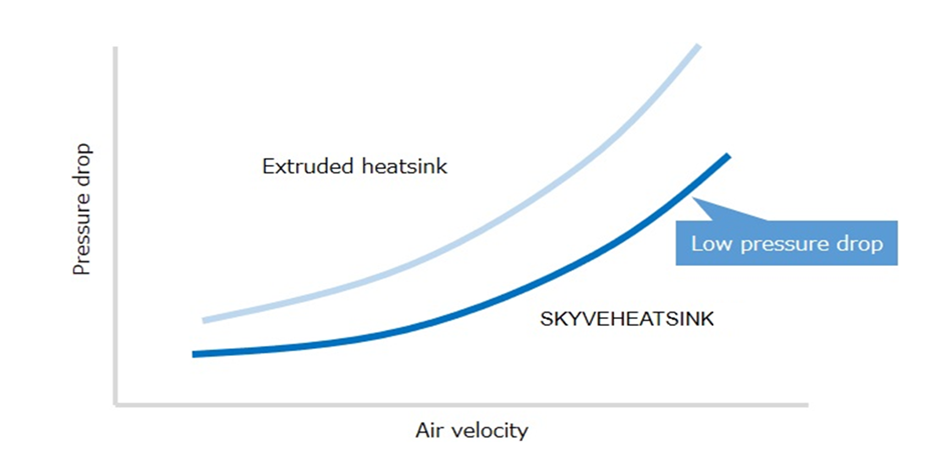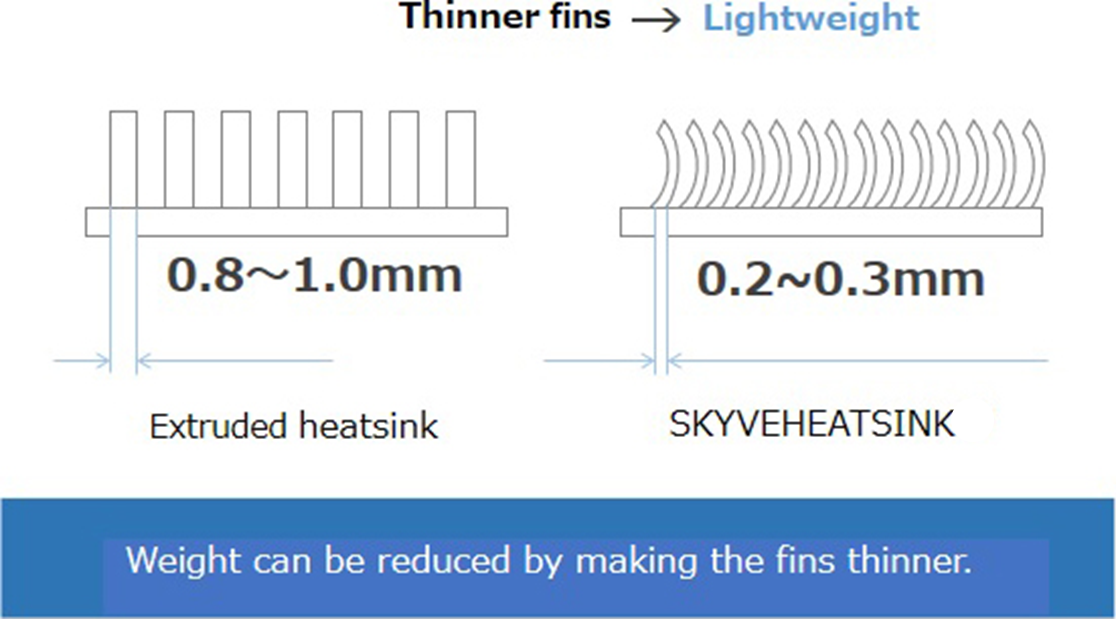- Category:
- Tag:
"SKYVEHEATSINK" realizing miniaturization and weight reduction

From 5G to Beyond 5G, the telecommunications industry is undergoing rapid development of broadband networks. As the traffic volume grows exponentially, the overheating of network devices is beginning to pose a major challenge. The demand for compact, lightweight network equipment is also increasing, as base stations become smaller and decentralized with the spread of high-frequency microcells or local 5G networks.
Conventionally, extruded heatsinks have been used to release the heat generated by communication equipment, but there were technical limits in terms of minimum fin thickness and pitch. Because the heatsink had to be larger to improve the heat dissipation performance, it was not uncommon for a heatsink to occupy nearly half the space in the network equipment.
As a solution to this problem, Resonac is proposing "SKYVEHEATSINK". With machine processing making it possible to reduce the fins' thickness and pitch, smaller, lighter heatsinks can now maintain the same level of heat dissipation performance as extruded heatsinks.(※1)
- ※1) Comparisons in this article were made under specific conditions. Based on our internal simulations, we will propose optimal specifications for individual cases according to the clients’ use conditions.
What is "SKYVEHEATSINK"?
~Compact, lightweight features made possible by reducing fin thickness and pitch to levels difficult to achieve with extruded models~
To improve the heat dissipation performance, the overall surface area of the heat-releasing fins must be increased. With extruded heatsinks it was difficult to reduce the fins’ thickness to less than 0.8 mm and the pitch narrower than 3 mm. Since the heatsink had to be larger to broaden the surface area, a trade-off between heat dissipation performance and compactness was inevitable.
However, the machine-processed fins of Resonac’s "SKYVEHEATSINK" can be thinned down to 0.2 mm, and the pitch can be as small as 1.5 mm. Even if the same size as an extruded heatsink, the number of fins and the total surface area can be increased. This enables the heatsink to be smaller and lighter without compromising on performance. By downsizing the heatsink, which generally occupies a large space in the network equipment, more communication devices can be installed in a limited area, increasing the capacity of the frequency bands. Because small, lightweight devices are also easier to install and replace, they improve the safety of installation work and ease the problems of cost and risks associated with manpower shortages.
By reducing the fins’ thickness to one-fourth of conventional models,(※2) pressure drop during cooling are lower than equivalent extruded heatsinks with thicker fins and larger cross-sectional areas. "SKYVEHEATSINK" is also an energy-saving solution that maximizes the air flow effect without raising the fan’s output.
- ※2) This is a comparison between the extruded heat sink’s minimum fin thickness (0.8 mm) and that of "SKYVEHEATSINK" (0.2 mm).
"SKYVEHEATSINK"

Features of "SKYVEHEATSINK"
Smaller and lighter than extruded heatsinks with similar heat dissipation performance
"SKYVEHEATSINK" can be made 24-percent smaller and 35-percent lighter than an extruded heatsink with equivalent heat dissipation performance. Even though reduced in size and weight, the price can be maintained at the same level, since the lower material cost cancels out the higher processing cost.
Comparison with an extruded heatsink with equivalent heat dissipation performance
(Extruded heatsink vs. Resonac’s SKYVEHEATSINK)

Low pressure drop during cooling contributes to the fan’s energy-saving effect
Thinner fins than an extruded heatsink’s help reduce pressure drop, making it possible to lower the fan’s output or to replace with a smaller model.
Comparison of pressure drop
(Extruded heatsink vs. Resonac’s SKYVEHEATSINK)

Size comparison of an extruded heatsink and Resonac’s "SKYVEHEATSINK"
Size comparison


For more specific data about "SKYVEHEATSINK", including its characteristics and uses, please refer to the technical materials.
- ※ "SKYVEHEATSINK" is a registered trademark of Resonac Corporation in Japan.
Need More Information?

Contact Us
Please don't hesitate to contact us if you have any questions.